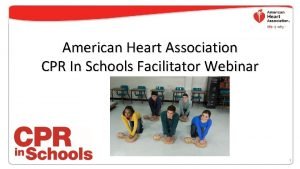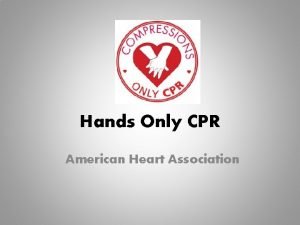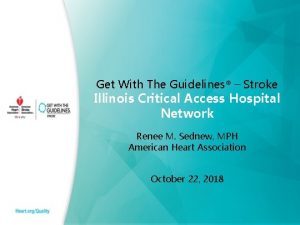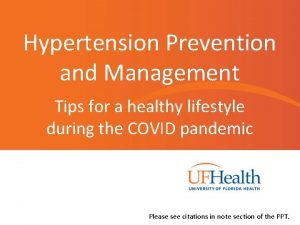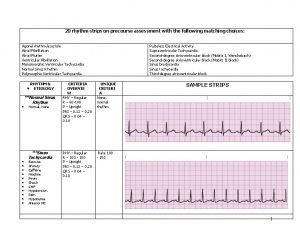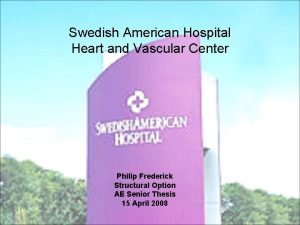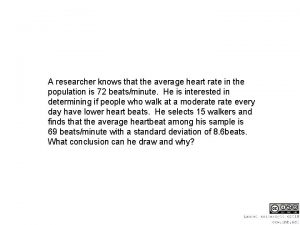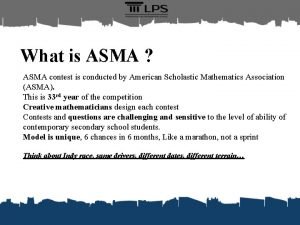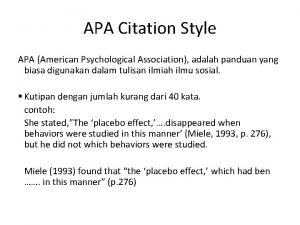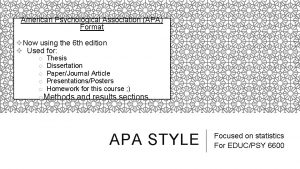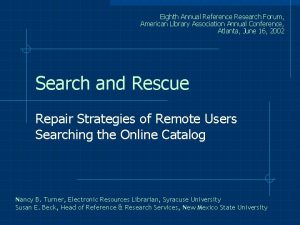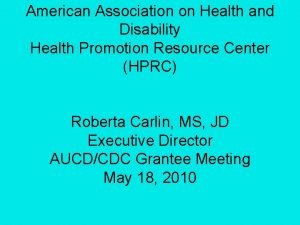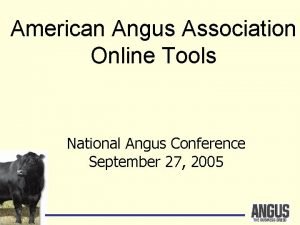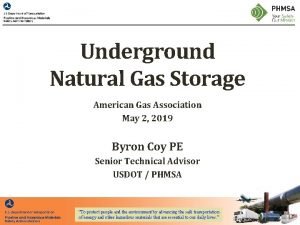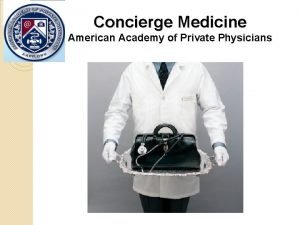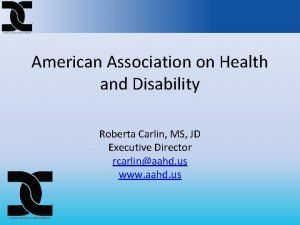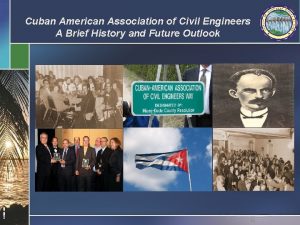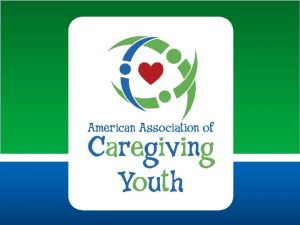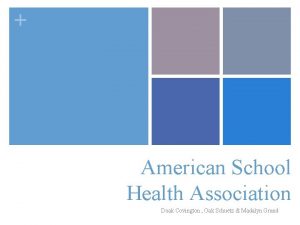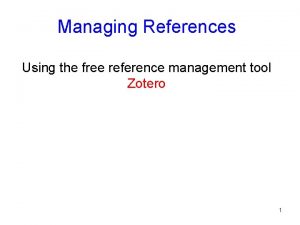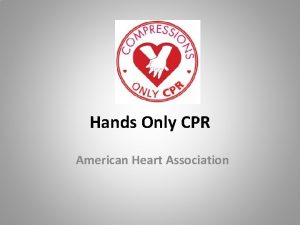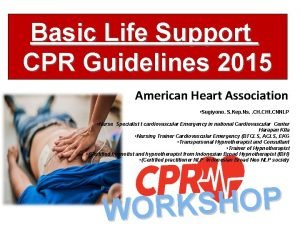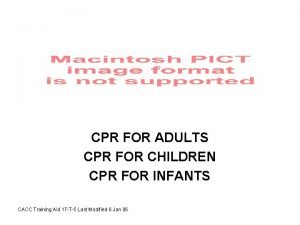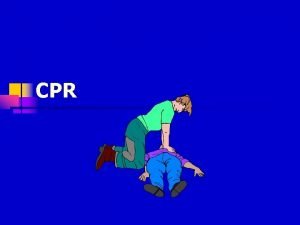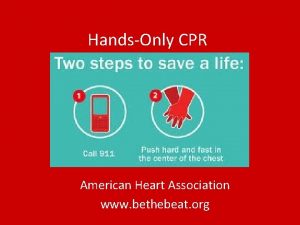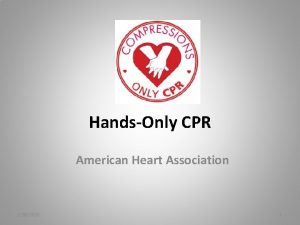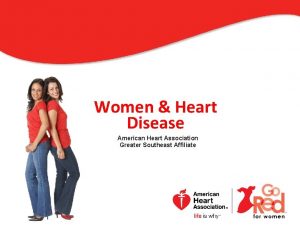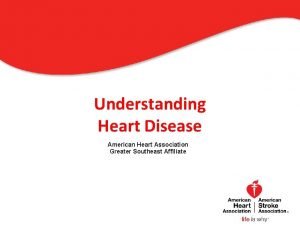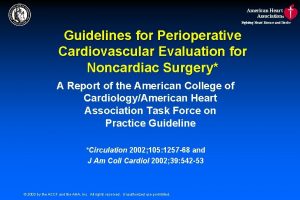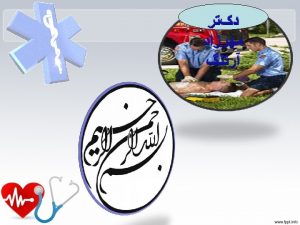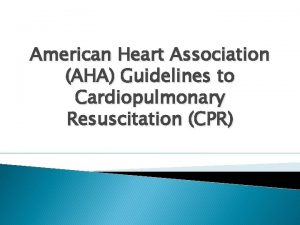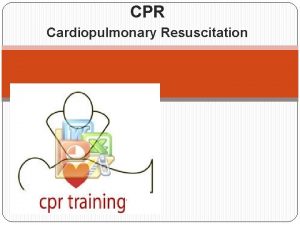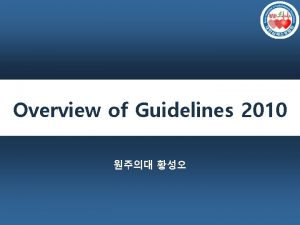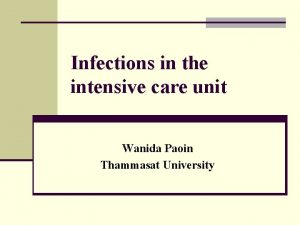American Heart Association Guidelines for CPR 2015 Wanida

















































- Slides: 49

American Heart Association Guidelines for CPR 2015 Wanida Chongarunngamsang, MD. Faculty of Srinakarinwirot University

American Heart Association Guidelines for CPR 2015 • BLS • ACLS – Pulseless Arrest – Bradycardia – Tachycardia • Post cardiac arrest care

Chains of Survival 2015 (New): Separate Chains of Survival (Figure 4) have been recommended that identify the different pathways of care for patients who experience cardiac arrest in the hospital as distinct from out-of-hospital settings

“Chain of Survival” in-hospital cardiac arrest (IHCA) • • • Surveillance for cardiac arrest Activate code (multidisciplinary team) Initiate CPR by professional providers Early defibrillation Integrated post cardiac arrest care

“Chain of Survival” out-of-hospital cardiac arrest (OHCA) • Immediate recognition of cardiac arrest and activation of the emergency response system • Early CPR that emphasizes chest compressions • Rapid defibrillation if indicated • Effective advanced life support • Integrated post cardiac arrest care

Adult Basic Life Support (BLS)

Basic Life Support – Used for patients with life-threatening illness or injury before the patient can be given full medical care. – Generally used in the pre-hospital setting, and can be provided without medical equipment. – Generally does not include the use of drugs or invasive skills. .

30: 2 x 5 cycle Breathing and pulse unresponsesive Pulse : breathing Call for help and AED 5 -6 sec No pulse : CPR

The BLS Survey includes four steps: • • The BLS survey is the starting point for all ACLS management Check for a response Call for help and to bring an AED Check circulation Check rhythm

The Primary Assessment uses the ABCDE model • Airway – Use the least advanced airway possible to maintain the airway and oxygenation • Breathing – Monitor tube placement and oxygenation using waveform capnography • Circulation – Medications, CPR, fluids and defibrillation • Differential Diagnosis –treat reversible causes • Disability- neurological assessment “AVPU”(Alert, Voice, Painful, Unresponsive) • Exposure - looking for signs of trauma, bleeding, burns, or medical alert bracelets

The Secondary Assessment • The secondary assessment includes a search for underlying causes for the emergency and if possible a focused medical history “SAMPLE’ • (S)Signs and symptoms • (A)Allergies • (M)Medications • (P)Past Illnesses • (L)Last Oral Intake • (E)Events Leading Up To Present Illness

Check pulse : carotid artery Start Chest compression if no definite pulse within 10 seconds


Chest compression

Chest compression

Chest compression กดลก 5 cm (2 inches) Full chest recoid

Minimal interruption • หลง defibrillation หรอ shock ใหกดหนาอกตอ ไมตองคลำชพจร • minimize the frequency and duration of interruptions in compressions • CPR without an advanced airway, goal of a chest compression fraction as high as possible, with a target of at least 60%.


Airway Head tilt Chin lift

Jaw thrust ถาสงสย injury C-spine

Breathing

BLS Dos and Don’ts of Adult High-Quality CPR Rescuers Should Not perform chest compressions at a rate of 100 -120/min Compress at a rate slower than 100/min or faster than 120/min Compress to a depth of at least 2 inches (5 Compress to a depth of less than 2 inches (5 cm) or greater than 2. 4 inches (6 cm) Allow full recoil after each compression Lean on the chest between compressions Minimize pauses in compressions Interrupt compressions for greater than 10 seconds Ventilate adequately (2 breaths after 30 Provide excessive ventilation (ie, too many breaths or breaths with excessive force) compressions, each breath delivered over 1 second, each causing chest rise)


AED (Automated External Defibrillator) AED ON กดปมเครองเปด และหมนปม AED on

AED (Automated External Defibrillator) ��� pad ��� sternum /apex

AED (Automated External Defibrillator) ������ electrode pad ����� electrode cable ������


AED (Automated External Defibrillator) กดเพอทำกา ร shock

Advanced Cardiovascular Life Support: ACLS

Advanced Cardiovascular Life Support: ACLS • Pulseless Arrest • Bradycardia with Pulse • Tachycardia with Pulse

Pulseless Arrest

shock Toxins Hypovolemia Tamponade Hypoxia Tension PTX Hydrogen ions (acidosis) Hyper/hypokalemia Thrombosis (coronary) Thrombosis (pulmonary) Hypothermia Amiodarone 300 mg----150 mg Pulse/BP Et. CO 2>40 mm. Hg A-line wave form 5 Hs, 5 Ts

Bradycardia with Pulse

Unstable bradycardia

Tachycardia with Pulse

Narrow regular 50 -100 j Narrow irregular 120 -200 j (mono 200 j) Unstable Tachycardia Wide regular 100 j Wide irregular DF

Quantitative Waveform Capnography • Confirmation and monitoring ETT placement • Evaluating the effectiveness of chest compressions ETCO 2 value is at least 10 -20 mm. Hg. • Identification of ROSC • Failure to achieve an ETCO 2 of greater than 10 mm Hg by waveform capnography after 20 minutes of CPR decide to end resuscitative efforts but should not be used in isolation

Capnography Recommendation

CPR Quality • Quantitative waveform capnography – If Petco 2<10 mm Hg, attempt to improve CPR quality • Intra-arterial pressure – If relaxation phase (diastolic) pressure <20 mm Hg, attempt to improve CPR quality

Defibrillator

Defibrillator

SBP >90 mm. Hg MAP>65 mm. Hg BT 32 C-36 C at least 24 hr

Ventricular tachycardia

Ventricular fibrillation

Pulseless electrical activity(PEA) NO PULSE

Supraventricular tachycardia

New and Updated Recommendations CPR Guideline 2015 • Separate Chain of Survival • Chest compressions at a rate of 100 to 120/min : extremely rapid compression rates with inadequate compression depth • Chest compressions at a depth of at least 2 inches or 5 cm for an average adult, while avoiding excessive chest compression depths (greater than 2. 4 inches [6 cm])

New and Updated Recommendations CPR Guideline 2015 • Delivery 1 breath every 6 seconds (10 /min) while continuous chest compression with advance airway • Vasopressin was removed from the ACLS Cardiac Arrest Algorithm • Nonshockable rhythm , administer epinephrine as soon as feasible (IV/IO/ET) • Targeted temperature management 32 C to 36 C in 24 hr • The routine prehospital cooling of patients with rapid infusion of cold IV fluids after ROSC is not recommended

Thank you
 Unresponsive child cpr
Unresponsive child cpr Aha cpr in schools training kit
Aha cpr in schools training kit American heart association
American heart association American thyroid association guidelines pregnancy 2017
American thyroid association guidelines pregnancy 2017 American heart association 2020
American heart association 2020 Jnc 8 classification of hypertension pdf
Jnc 8 classification of hypertension pdf Acls helpful hints
Acls helpful hints Percussion of right border of heart
Percussion of right border of heart Left atrium sheep heart
Left atrium sheep heart Hrt to hrt merrylands
Hrt to hrt merrylands Swedish american heart hospital rockford illinois
Swedish american heart hospital rockford illinois American researcher who involved in getting heart rate
American researcher who involved in getting heart rate American scholastic mathematics association past papers
American scholastic mathematics association past papers American association for artificial intelligence 17 mar
American association for artificial intelligence 17 mar American galvanizers association inc
American galvanizers association inc Brandz pyramid
Brandz pyramid American berkshire association
American berkshire association American baking association
American baking association How to do in-text citations apa
How to do in-text citations apa Style apa adalah
Style apa adalah Apa table format 7th edition
Apa table format 7th edition American alzheimer's association
American alzheimer's association American library association
American library association New york mental health counselors association
New york mental health counselors association North american gaming regulators association
North american gaming regulators association North american association for environmental education
North american association for environmental education American library association
American library association American pyrotechnics association
American pyrotechnics association American psychiatric association annual meeting 2020
American psychiatric association annual meeting 2020 American association on health and disability
American association on health and disability American angus gestation calculator
American angus gestation calculator American gas association
American gas association Mobile baptist association
Mobile baptist association The concierge academy
The concierge academy Psychiatric nurse conference
Psychiatric nurse conference Roberta carlin
Roberta carlin Caace gala
Caace gala Aacy
Aacy American statistical association salary survey
American statistical association salary survey Donmeg developments
Donmeg developments Aafp metric
Aafp metric American school health association conference
American school health association conference Gelbvieh.org
Gelbvieh.org American association of drilling engineers
American association of drilling engineers American marketing association
American marketing association Formula brooke
Formula brooke Pemasaran menurut american marketing association
Pemasaran menurut american marketing association Vancouver bibliography
Vancouver bibliography Journal of american medical informatics association
Journal of american medical informatics association American psichological association
American psichological association

